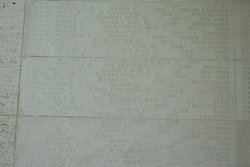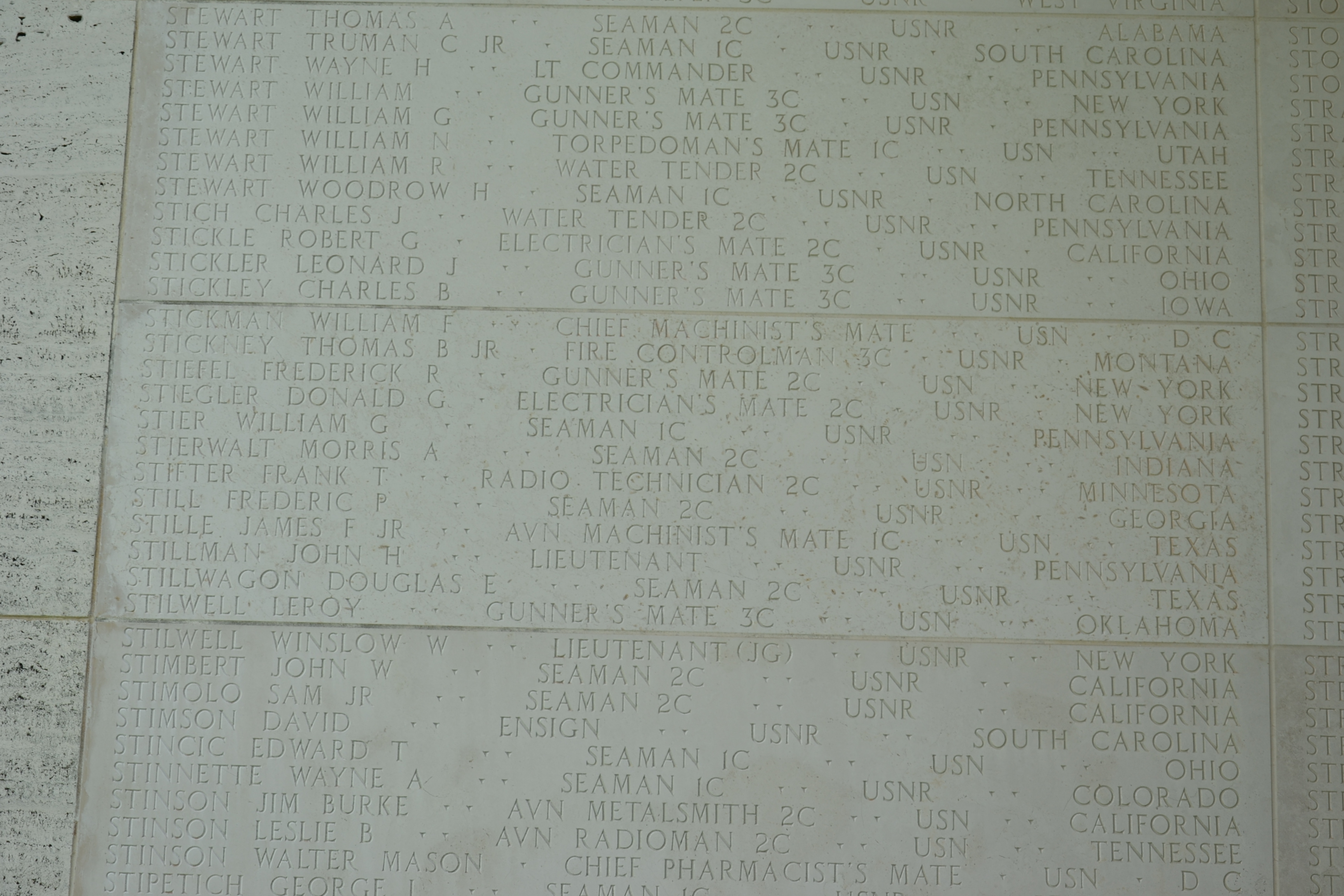Parents, Mr. and Mrs. George Buchanan Stillwagon, 3716 Elmora St., Houston, Tex.
Missing, later declared dead October 26, 1945
Battle of Samar, Philippine Sea, missing, date of loss October 25, 1944
----------------------------------------------------------------------------------------------------------
Taffy 3
After replenishing at Seeadler Harbor of Manus, Admiralty Islands, Hoel cleared that base with a fire support group 12 October 1944 to join Rear Admiral Thomas L. Sprague's escort carrier group (Task Group 77.4) in invading the Philippines. Sprague's force was composed of three units, each comprising a group of escort carriers and a screen of destroyers and destroyer escorts. These units, known by their radio calls as the "Three Taffys", began operating off Samar 18 October 1944 to cover the landings on Leyte. Hoel was attached to "Taffy 3" (Escort Carrier Task Unit 77.4.3) commanded by Rear Admiral Clifton A. F. Sprague and comprising four escort carriers guarded by destroyers Hoel, Heermann, and Johnston. Before the Battle off Samar, "Taffy 3" was reinforced by the arrival of Admiral Ralph A. Ofstie with two more escort carriers and Dennis, John C. Butler, Raymond, and Samuel B. Roberts.
Battle off Samar
Dawn of 25 October 1944 found "Taffy 3" steaming northeast of Samar operating as the Northern Air Support Group. "Taffy 2" was in the central position patrolling off the entrance to Leyte Gulf, and "Taffy 1" covered the southern approaches to the Gulf some 150 miles (240 km) to the southeast of Hoel's "Taffy 3". Rear Admiral Clifton A. F. Sprague was under the erroneous impression that Admiral William Halsey's 3d Fleet was providing protection to the north and so was taken by surprise when at 06:45 'Taffy 3"'s lookouts observed anti-aircraft fire to the northward and within three minutes were under heavy fire from Vice Admiral Takeo Kurita's powerful Center Force of 4 battleships, 6 heavy cruisers, 2 light cruisers, and 11 destroyers.
The only chance for survival of the little group of American "Jeep" carriers and "tin cans" lay in running to the east long enough to launch what aircraft could be readied before fleeing to the south hoping that aid would arrive before their complete destruction. While the carriers launched all available aircraft to attack their numerous Japanese adversaries and then formed a rough circle as they turned toward Leyte Gulf, Hoel and her fellow destroyers Johnston and Heermann, worked feverishly to lay down a smoke screen to hide their "baby flattops" from the overwhelmingly superior enemy ships. At 07:06, when a providential rain squall helped to hide his carriers, Admiral Clifton Sprague boldly ordered his destroyers to attack the Japanese with torpedoes. Hoel instantly obeyed this order by heading straight for the nearest enemy battleship, Kongō, then 18,000 yards (16,000 m) away. When she had closed to 14,000 yards (13,000 m) she opened fire as she continued her race toward Kongō's 14-inch (356 mm) guns. A hit on her bridge which knocked out all voice radio communication did not deflect her from her course toward the enemy until she had launched a half salvo of torpedoes at a range of 9,000 yards (8,200 m). Although Hoel's torpedoes all failed to strike their target, they caused Kongō to lose ground in her pursuit of the carriers by forcing her to turn sharply left and to continue to move away from her quarry until they had run their course. Minutes later Hoel suffered hits which knocked out three of her guns, stopped her port engine, and deprived her of her Mark-37 fire control director, FD radar, and Bridge steering control.
Undaunted, Hoel turned to engage what her crew believed to be an column of enemy heavy cruisers which were actually the battleships Haruna and Yamato. When she had closed to within 6,000 yards (5,500 m) of the leading ship, identified as Haguro but more likely Yamato or possibly Haruna, the destroyer launched a half-salvo of torpedoes which ran "hot, straight and normal." This time her crew was rewarded by the sight of large columns of water alongside their target, seemingly signifying hits. This observation may have been illusory, as neither Haruna nor Haguro received torpedo damage and explosions may have been near miss bombs from the constant air attacks. Track charts of the battle indicate the most likely target of this attack was actually Kurita's flagship Yamato, which was forced to turn north to evade these torpedoes, taking Kurita away from the battle at a critical moment and causing him to lose control of his forces.
Hoel now found herself crippled and surrounded by enemies. Kongō was only 8,000 yards (7,300 m) off her port beam, and the heavy cruiser column was some 7,000 yards (6,400 m) off her port quarter. During the next hour the ship rendered her final service by drawing enemy fire to herself and away from the carriers. In the process of fishtailing and chasing salvos she peppered them with her two remaining guns. Finally at 08:30, after withstanding over 40 hits, an 8-inch (203 mm) shell stilled her last working engine. With her engine room under water, her No. 1 magazine ablaze, and the ship listing heavily to port and settling by the stern, Hoel's captain, Commander Leon S. Kintberger, ordered his crew to "prepare to abandon ship." The Japanese fire at the doomed ship continued as her surviving officers and men went over the side and only stopped at 08:55 when Hoel rolled over and sank.
Only 86 of Hoel's complement survived; 253 officers and men died with their ship, at least 40 of them dying in the water while awaiting rescue. Commander Kintberger described the courageous devotion to duty of the men of the Hoel in a seaman's epitaph to the action: "Fully cognizant of the inevitable result of engaging such vastly superior forces, these men performed their assigned duties coolly and efficiently until their ship was shot from under them."
(Source: Wikipedia)
Parents, Mr. and Mrs. George Buchanan Stillwagon, 3716 Elmora St., Houston, Tex.
Missing, later declared dead October 26, 1945
Battle of Samar, Philippine Sea, missing, date of loss October 25, 1944
----------------------------------------------------------------------------------------------------------
Taffy 3
After replenishing at Seeadler Harbor of Manus, Admiralty Islands, Hoel cleared that base with a fire support group 12 October 1944 to join Rear Admiral Thomas L. Sprague's escort carrier group (Task Group 77.4) in invading the Philippines. Sprague's force was composed of three units, each comprising a group of escort carriers and a screen of destroyers and destroyer escorts. These units, known by their radio calls as the "Three Taffys", began operating off Samar 18 October 1944 to cover the landings on Leyte. Hoel was attached to "Taffy 3" (Escort Carrier Task Unit 77.4.3) commanded by Rear Admiral Clifton A. F. Sprague and comprising four escort carriers guarded by destroyers Hoel, Heermann, and Johnston. Before the Battle off Samar, "Taffy 3" was reinforced by the arrival of Admiral Ralph A. Ofstie with two more escort carriers and Dennis, John C. Butler, Raymond, and Samuel B. Roberts.
Battle off Samar
Dawn of 25 October 1944 found "Taffy 3" steaming northeast of Samar operating as the Northern Air Support Group. "Taffy 2" was in the central position patrolling off the entrance to Leyte Gulf, and "Taffy 1" covered the southern approaches to the Gulf some 150 miles (240 km) to the southeast of Hoel's "Taffy 3". Rear Admiral Clifton A. F. Sprague was under the erroneous impression that Admiral William Halsey's 3d Fleet was providing protection to the north and so was taken by surprise when at 06:45 'Taffy 3"'s lookouts observed anti-aircraft fire to the northward and within three minutes were under heavy fire from Vice Admiral Takeo Kurita's powerful Center Force of 4 battleships, 6 heavy cruisers, 2 light cruisers, and 11 destroyers.
The only chance for survival of the little group of American "Jeep" carriers and "tin cans" lay in running to the east long enough to launch what aircraft could be readied before fleeing to the south hoping that aid would arrive before their complete destruction. While the carriers launched all available aircraft to attack their numerous Japanese adversaries and then formed a rough circle as they turned toward Leyte Gulf, Hoel and her fellow destroyers Johnston and Heermann, worked feverishly to lay down a smoke screen to hide their "baby flattops" from the overwhelmingly superior enemy ships. At 07:06, when a providential rain squall helped to hide his carriers, Admiral Clifton Sprague boldly ordered his destroyers to attack the Japanese with torpedoes. Hoel instantly obeyed this order by heading straight for the nearest enemy battleship, Kongō, then 18,000 yards (16,000 m) away. When she had closed to 14,000 yards (13,000 m) she opened fire as she continued her race toward Kongō's 14-inch (356 mm) guns. A hit on her bridge which knocked out all voice radio communication did not deflect her from her course toward the enemy until she had launched a half salvo of torpedoes at a range of 9,000 yards (8,200 m). Although Hoel's torpedoes all failed to strike their target, they caused Kongō to lose ground in her pursuit of the carriers by forcing her to turn sharply left and to continue to move away from her quarry until they had run their course. Minutes later Hoel suffered hits which knocked out three of her guns, stopped her port engine, and deprived her of her Mark-37 fire control director, FD radar, and Bridge steering control.
Undaunted, Hoel turned to engage what her crew believed to be an column of enemy heavy cruisers which were actually the battleships Haruna and Yamato. When she had closed to within 6,000 yards (5,500 m) of the leading ship, identified as Haguro but more likely Yamato or possibly Haruna, the destroyer launched a half-salvo of torpedoes which ran "hot, straight and normal." This time her crew was rewarded by the sight of large columns of water alongside their target, seemingly signifying hits. This observation may have been illusory, as neither Haruna nor Haguro received torpedo damage and explosions may have been near miss bombs from the constant air attacks. Track charts of the battle indicate the most likely target of this attack was actually Kurita's flagship Yamato, which was forced to turn north to evade these torpedoes, taking Kurita away from the battle at a critical moment and causing him to lose control of his forces.
Hoel now found herself crippled and surrounded by enemies. Kongō was only 8,000 yards (7,300 m) off her port beam, and the heavy cruiser column was some 7,000 yards (6,400 m) off her port quarter. During the next hour the ship rendered her final service by drawing enemy fire to herself and away from the carriers. In the process of fishtailing and chasing salvos she peppered them with her two remaining guns. Finally at 08:30, after withstanding over 40 hits, an 8-inch (203 mm) shell stilled her last working engine. With her engine room under water, her No. 1 magazine ablaze, and the ship listing heavily to port and settling by the stern, Hoel's captain, Commander Leon S. Kintberger, ordered his crew to "prepare to abandon ship." The Japanese fire at the doomed ship continued as her surviving officers and men went over the side and only stopped at 08:55 when Hoel rolled over and sank.
Only 86 of Hoel's complement survived; 253 officers and men died with their ship, at least 40 of them dying in the water while awaiting rescue. Commander Kintberger described the courageous devotion to duty of the men of the Hoel in a seaman's epitaph to the action: "Fully cognizant of the inevitable result of engaging such vastly superior forces, these men performed their assigned duties coolly and efficiently until their ship was shot from under them."
(Source: Wikipedia)
Inscription
STILLWAGON DOUGLAS E - SEAMAN 2C - USNR - TEXAS
Family Members
Sponsored by Ancestry
Advertisement
Advertisement









